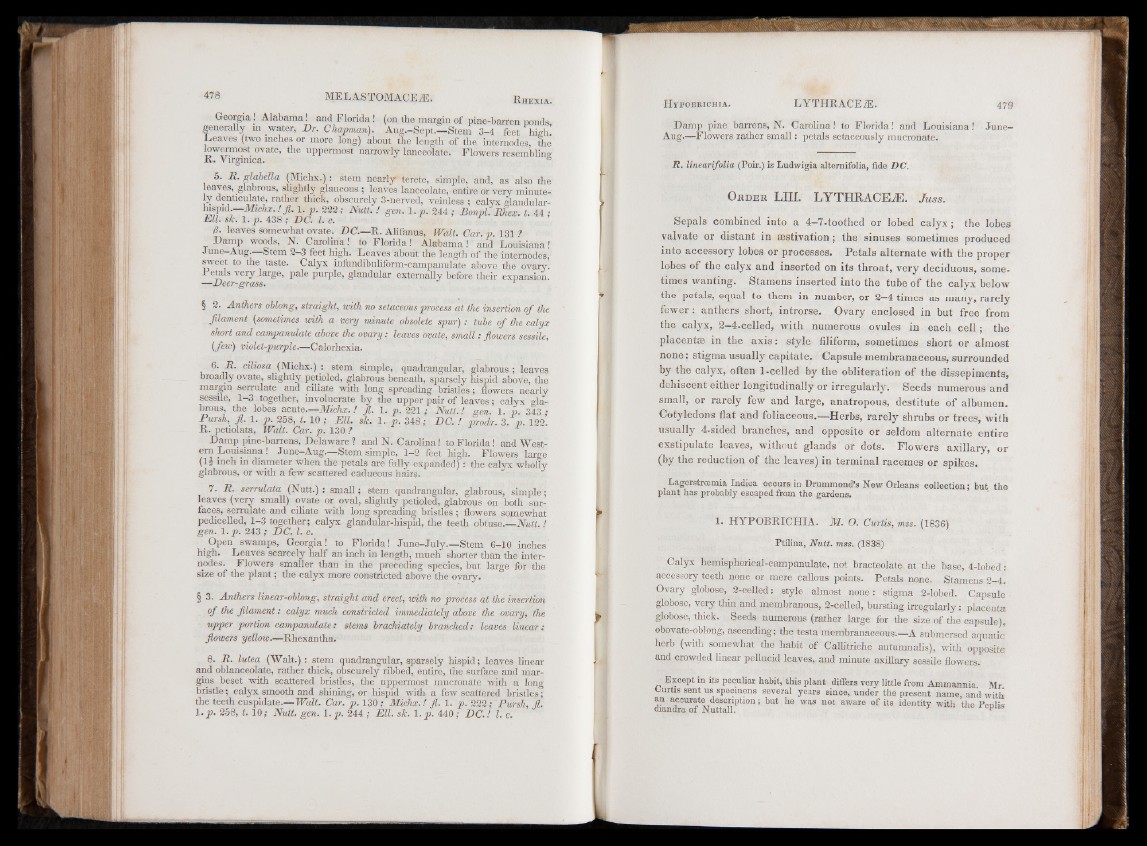
Georgia ! Alabama! and Florida ! (on the margin of pine-barren ponds,
generally m water, Dr. Chapman). Aug.-Sept— Stem 3-4 feet high!
Eeaves (two inches or more long) about the length of the internodes, the
mwermost ovate, the uppermost narrowly lanceolate. Flowers resembling
ft. Virgimca. °
5. R. glabella (Michx.): stem nearly terete, simple, and, as also the
leaves, glabrous, slightly glaucous ; leaves lanceolate, entire or very minutely
denticulate, rather thick, obscurely 3-nerved, veinless ; calyx glandular-
hispid.—Michx.! fi. 1. p. 222; Nutt. ! gen. l .p . 244 ; Bonpl. Rhex. t. 44 ;
Ell. sic, l .p . 438 ; DC. l.c. r
/?. leaves somewhat ovate. DC.—R. Alifanus, Walt. Car. p. 131 ?
Damp woods, N. Carolina! to Florida! Alabama ! and Louisiana!
June-Aug.—Stem 2-3 feet high. Leaves about the length of the internodes,
sweet to the taste. Calyx infundibuliform-campanulate above the ovary.
Petals very large, pale purple, glandular externally before their expansion.
—Deer-grass.
§ 2. Anthers oblong, straight, with no setaceous process at the insertion o f the
filament (sometimes with a very minute obsolete spur): tube of the calyx
short and campanulate above the ovary: leaves ovate, small: flowers sessile,
(few) violet-purple.—Calorhexia.
6. R. ciliosa (Michx.) : stem simple, quadrangular, glabrous ; leaves
broadly ovate, slightly petioled, glabrous beneath, sparsely hispid above, the
margin serrulate and ciliate with long spreading bristles; flowers nearly
sessile, 1-3 together, involucrate by the upper pair of leaves; calyx glabrous,
the lobes acute.—Michx. ! fi. 1. p. 221; Nutt.! gen. 1. p. 343 •
Pursh, fi. 1. p. 258, t. 10 ; Ell. sic. 1. p. 348; DC, ! prodr. 3. p. 122.
R. petiolata, Walt. Car. p. 130 ? _
Damp pine-barrens, Delaware ? and N. Carolina! to Florida! and Western
Louisiana ! June-Aug.—Stem simple, 1-2 feet high. Flowers large
(14 inch in diameter when the petals are fully expanded) : the calyx wholly
glabrous, or with a few scattered cadueous hairs.
7. R. serrulata (Nutt.): small; stem quadrangular, glabrous, simple;
leaves (very small) ovate or oval, slightly petioled, glabrous on both surfaces,
serrulate and ciliate with long spreading bristles ; flowers somewhat
pedicelled, 1-3 together; calyx glandular-hispid, the teeth obtuse.—Nutt. !
gen. 1. p. 243 ; DC. 1. c.
Open swamps, Georgia! to Florida! June-July.—Stem 6-10 inches
high. Leaves scarcely half an inch in length, much shorter than the internodes.
Flowers smaller than in the preceding species, but large for the
size of the plant; the calyx more constricted above the ovary.
§ 3. Anthers linear-oblong, straight and erect, with no process at the insertion
of the filament: calyx much constricted immediately above the ovary, the
upper portion campanulate: stems brachiately branched: leaves linear:
flowers yellow.—Rhexantha.
8. R. lutea (Walt.): stem quadrangular, sparsely hispid; leaves linear
and oblaneeolate, rather thick, obscurely ribbed, entire, the surface and margins
beset with scattered bristles, the uppermost mucronate with a long
bristle; calyx smooth and shining, or hispid with a few scattered bristles;
the teeth cuspidate— Walt. Car. p. 130 ; Michx.! ft. 1. p. 222; Pursh, fi.
l .p . 258, t. 10; Nutt. gen. l .p . 244 ; Ell. sic. l .p . 440; DC. f l. c.
Damp pine barrens, N. Carolina ! to Florida! and Louisiana! June-
Aug.—Flowers rather small: petals setaceously mucronate.
R. linearifolia (Poir.) is Ludwigia alternifolia, fide DC.
Or d e r LIII. LYTH RA C EiE. Juss.
Sepals combined into a 4-7-toothed or lobed c a ly x ; the lobes
valvate or distant in asstivation; the sinuses sometimes produced
into accessory lobes or processes. Petals alternate with the proper
lobes o f the calyx and inserted on its throat, very deciduous, sometimes
wanting. Stamens inserted into the tube o f the calyx below
the petals, equal to them in number, or 2 -4 times as many, rarely
fewer : anthers short, introrse. Ovary enclosed in but free from
the calyx, 2-4-ce lled , with numerous ovules in each c e l l ; the
placentae in the a x is : sty le filiform, sometimes short or almost
n on e : stigma usually capitate. Capsule membranaceous, surrounded
by the calyx, often 1-celled by the obliteration o f the dissepiments,
dehiscent either longitudinally or irregularly. Seeds numerous and
small, or rarely few and large, anatropous, destitute o f albumen.
Cotyledons flat and foliaceous.— Herbs, rarely shrubs or trees, with
usually 4-sided branches, and opposite or seldom alternate entire
exstipulate leaves, without glands or dots. Flowers axillary, or
(by the reduction o f the leaves) in terminal racemes or spikes.
Lagerstrcemia Indica occurs in Drummond’s New Orleans collection; but the
plant has probably escaped from the gardens.
1. HYPOBRICHIA. M. O. Curtis, mss. (1836)
Ptilina, Nutt. mss. (1838)
Calyx hemispherical-campanulate, not bracteolate at the base, 4-lobed:
accessory teeth none or mere callous points. Petals none. Stamens 2-4.
Ovary globose, 2-celled: style almost none: stigma 2-lobed. Capsule
globose, very thin and membranous, 2-celled, bursting irregularly: placenta
globose, thick. Seeds numerous (rather large for the size of the capsule),
obovate-oblong, ascending; the testa membranaceous.—A submersed aquatic
herb (with somewhat the habit of Callitriche autumnalis), with opposite
and crowded linear pellucid leaves, and minute axillary sessile flowers.
Except in its peculiar habit, this plant differs very little from Ammannia Mr
Durt:s sent us specmens several years since, under the present name, and with
an accurate description; but he was not aware of its identity with the Penlis
diandra of Nuttall. F